When it comes to food, America does things its own way—and the rest of the world can’t help but raise an eyebrow. From peanut butter and jelly sandwiches that puzzle Europeans to deep-fried butter that leaves visitors speechless, classic American foods often walk the line between comfort and chaos. These dishes are woven into the nation’s culture, popping up at potlucks, tailgates, and holiday tables, but to outsiders, they can feel like culinary curiosities. Whether sweet, salty, or deep-fried, these 21 iconic American eats prove that taste buds—and traditions—truly vary around the globe.
1. Rocky Mountain Oysters
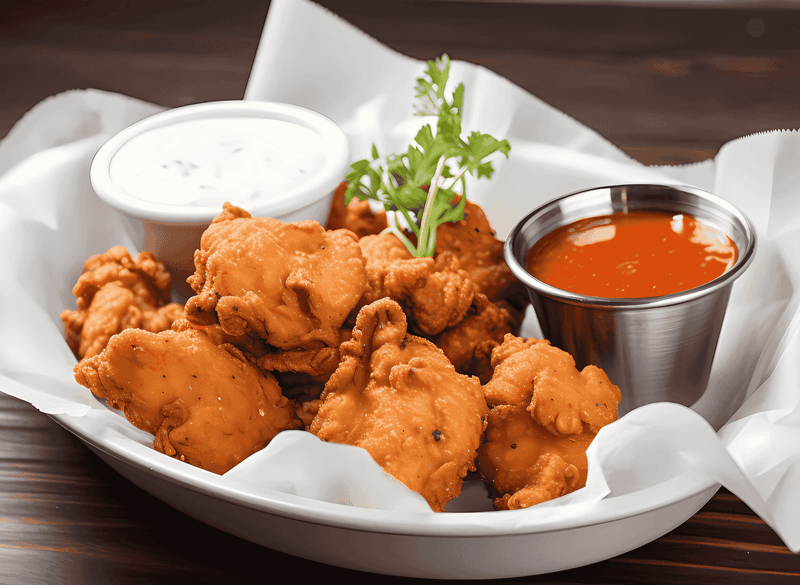
Despite their seafood-suggesting name, these aren’t oysters at all. They’re actually bull testicles that have been skinned, sliced, breaded, and deep-fried to crispy perfection.
A true Western delicacy with roots in ranching culture, these unusual morsels are typically served with cocktail sauce or hot sauce. Cowboys historically made use of every part of the animal after cattle brandings.
Visitors from abroad are often tricked into trying them before learning what they really are, leading to memorable reactions. In Colorado and Montana, they’re celebrated at festivals where locals proudly embrace this peculiar protein.
2. Jell-O Salad

Vibrant, wobbly, and trapped in time, this mid-century creation combines gelatin with an assortment of suspended ingredients. Fruit cocktail, marshmallows, cottage cheese, and even vegetables like shredded carrots or celery might make an appearance in these colorful concoctions.
Popular during the 1950s and 60s when convenience foods reigned supreme, Jell-O salads still appear at potlucks and family gatherings across America. The sweet-savory combinations particularly baffle international visitors.
Regional variations exist, from the Midwest’s “church basement” versions to Southern takes featuring Coca-Cola or pretzels. Some families guard their lime Jell-O with shredded cabbage recipes like precious heirlooms.
3. Cincinnati Chili

Born from Greek immigrants’ culinary influence, this Midwestern specialty bears little resemblance to Texan chili. The thin, cinnamon-spiced meat sauce is ladled over spaghetti and served in numbered “ways” with various toppings.
A “three-way” includes shredded cheese, while a “five-way” adds beans and onions. The distinct flavor profile comes from unexpected spices like allspice, chocolate, and cloves.
Loyal fans defend it passionately, while visitors often struggle with the concept of chili as a pasta sauce. Skyline and Gold Star restaurants compete for Cincinnati chili supremacy, and locals consume it with oyster crackers and hot sauce, often multiple times weekly.
4. Sweet Potato Casserole with Marshmallows

This Thanksgiving staple perfectly encapsulates America’s tendency to blur the line between side dish and dessert. Orange sweet potatoes are mashed with brown sugar, butter, and spices, then topped with a layer of pillowy marshmallows that get toasted to golden perfection.
The dish originated in the early 20th century when marshmallow companies were looking for new ways to market their product. Now it’s a holiday tradition that European visitors find particularly perplexing.
Regional variations might include pecans, streusel topping, or even a splash of bourbon. Some families engage in heated debates about whether this sweet concoction belongs on the dinner table or should be reserved for the dessert spread.
5. Peanut Butter and Jelly Sandwich

A cornerstone of American childhood, this simple sandwich mystifies many international palates. The combination of sticky-sweet fruit jam with salty, creamy peanut butter between slices of soft white bread represents lunchbox nostalgia for generations of Americans.
Outside the U.S., the concept often raises eyebrows. Many countries view peanut butter as exclusively savory, making the sweet pairing seem odd.
The PB&J gained popularity during World War II when soldiers combined their rations. Today, Americans consume enough peanut butter annually to coat the floor of the Grand Canyon! The sandwich has inspired everything from gourmet restaurant interpretations to specialized kitchen gadgets designed to create the perfect sealed edges.
6. Deep-Fried Butter

The pinnacle of state fair excess, deep-fried butter takes America’s love affair with fried foods to its logical extreme. Frozen butter balls are dipped in sweet batter, then plunged into bubbling oil until golden brown.
When bitten into, the now-melted butter creates a sauce-like interior that soaks the surrounding fried shell. Often dusted with powdered sugar or drizzled with honey, this creation debuted at the Texas State Fair and quickly became infamous.
Health experts predictably denounce it, while fair-goers line up to try this once-a-year indulgence. International visitors often cite this dish when discussing American dietary habits, viewing it as the ultimate symbol of culinary excess and deep-frying obsession.
7. Spray Cheese

Affectionately nicknamed “cheese in a can,” this shelf-stable, processed dairy product defies international cheese standards. With a push of the nozzle, bright orange, whipped cheese-like substance emerges in decorative patterns—no refrigeration required.
Americans squirt it on crackers, celery sticks, or directly into their mouths. The product was developed in the 1960s during America’s convenience food revolution and remains a grocery store staple.
Cheese connoisseurs from France and Italy express particular horror at this invention. The texture falls somewhere between mousse and putty, while the flavor bears only a passing resemblance to actual cheese. Nevertheless, its convenience and nostalgic appeal keep it on American shelves decades after its introduction.
8. Green Bean Casserole

Created in 1955 by Campbell’s test kitchen, this Thanksgiving mainstay combines canned green beans, cream of mushroom soup, and crispy fried onions. The recipe was designed to use ingredients found in most American pantries, becoming an instant hit for its simplicity and comfort-food appeal.
Europeans often question why fresh vegetables are replaced with canned versions. The casserole’s appeal lies in its creamy texture and the contrast between the soft beans and crunchy onion topping.
Family recipes are passed down with minor variations—some add cheese, water chestnuts, or bacon. An estimated 20 million American households serve this dish each Thanksgiving, despite visitors from abroad finding the mushroom soup base and soft texture particularly strange.
9. Fluffernutter

Marshmallow fluff—a spreadable, sticky confection—meets peanut butter between slices of pillowy white bread in this uniquely American creation. The sweet-and-salty combination creates a texture experience that’s simultaneously gooey, creamy, and soft.
Originating in New England in the early 1900s, the sandwich became popular during World War I as an inexpensive protein source. Massachusetts has gone so far as to declare it the official state sandwich.
Europeans often find the sugar content shocking, as a single Fluffernutter can contain more sugar than many European desserts. American children have been taking these to school for generations, though many modern schools have restricted them due to peanut allergies and nutritional concerns.
10. Spam
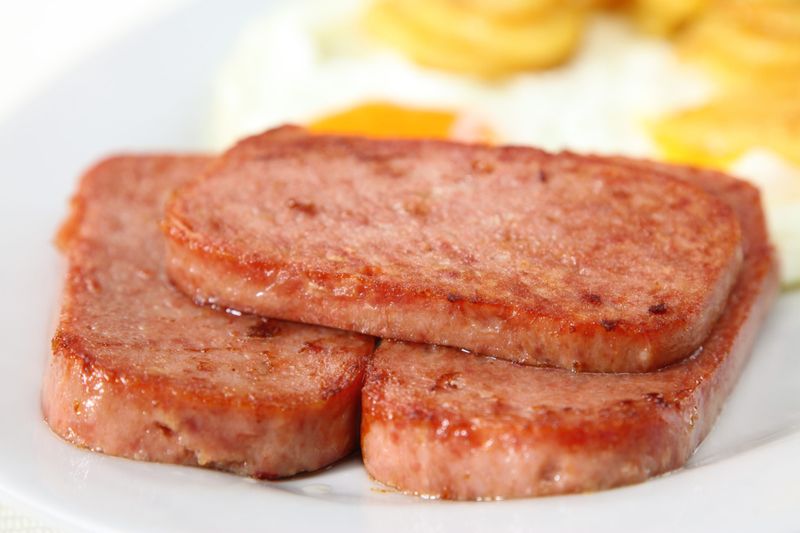
This pink brick of processed pork shoulder and ham has transcended its humble origins to become an American food icon. Introduced during the Great Depression and popularized during World War II when fresh meat was scarce, Spam comes in a distinctive blue and yellow tin with a key to open it.
While mainland Americans now view it with mixed feelings, Hawaii embraces Spam enthusiastically. Spam musubi—grilled Spam on rice wrapped with seaweed—is a Hawaiian staple found everywhere from convenience stores to high-end restaurants.
The product’s gelatinous texture and high sodium content puzzle many international visitors. Yet Spam’s global reach during American military occupations has created unexpected pockets of popularity in places like South Korea, the Philippines, and Guam.
11. Kool-Aid Pickles

Also known as “Koolickles,” these bright red, sweet-and-sour creations emerged from the Mississippi Delta region. Regular dill pickles are drained of brine, then soaked in strong, sweetened Kool-Aid (usually cherry or tropical punch flavor) for days until they absorb the color and sweetness.
The resulting pickle retains its vinegary tang but gains a fruity sweetness and shocking color that can range from electric red to neon blue. Children particularly love them for their candy-like appearance and flavor profile.
Outside America, the combination of pickle sourness with artificial fruit flavor seems especially bizarre. They’re sold at county fairs, convenience stores in the South, and even some school cafeterias, though making them at home has become something of a social media trend.
12. Porcupine Meatballs

These whimsically named meatballs earned their title from the uncooked rice mixed into the ground beef, which pokes out like tiny quills as they cook. A classic American comfort food from the Great Depression era, they represented an economical way to stretch meat by adding inexpensive rice.
Typically simmered in tomato sauce until the rice is tender, they create a hearty one-pot meal that many Americans remember from childhood. The rice absorbs flavors while adding unique texture.
International visitors find the name alarming until the explanation is provided. Many American grandmothers have treasured recipes for these, often cooked in a slow cooker or pressure cooker for modern convenience. The dish represents America’s pragmatic approach to home cooking during challenging economic times.
13. Chitterlings (Chitlins)

Few American dishes require more dedicated preparation than chitlins—pig intestines that must be meticulously cleaned before slow-cooking. With roots in slave cooking traditions, chitlins represent the resourcefulness of African Americans who transformed discarded animal parts into sustenance.
The cleaning process is notoriously aromatic, leading to the saying “If you can stand the smell, you can eat the chitlins.” They’re typically boiled for hours, then fried and served with hot sauce or vinegar.
Now considered soul food, chitlins remain a holiday tradition in many Black households despite their labor-intensive preparation. Foreign visitors are often surprised that Americans voluntarily eat intestines, though many cultures worldwide have similar dishes—just prepared and seasoned differently.
14. Pumpkin Pie

This quintessential Thanksgiving dessert baffles visitors from countries where pumpkin is strictly a savory vegetable. The smooth, spiced custard filling sits in a flaky crust, typically topped with a dollop of whipped cream.
The flavor profile combines earthy pumpkin with warm cinnamon, nutmeg, ginger, and cloves. Native Americans introduced European settlers to pumpkins, but the sweet pie interpretation developed over generations of American baking.
Europeans often describe their first pumpkin pie experience as “surprisingly sweet” or “confusingly spiced.” The canned pumpkin industry thrives almost exclusively because of this dessert, with most pies in America made from canned rather than fresh pumpkin. Some traditional recipes include unexpected ingredients like molasses or maple syrup.
15. Fried Cheese Curds

Fresh cheese curds—the squeaky, rubbery byproducts of cheddar production—become a Midwestern delicacy when battered and deep-fried. These golden nuggets burst with molten cheese when bitten, creating an irresistible textural experience that’s crispy outside and gooey inside.
Wisconsin proudly claims this dish as its own, serving it at everything from county fairs to upscale restaurants. The best versions use same-day fresh curds, which “squeak” against the teeth when fresh—a quality cherished by connoisseurs.
Visitors from abroad often compare them to mozzarella sticks but find the cheese’s texture and mild flavor distinctive. They’re typically served with ranch dressing or marinara sauce for dipping. During Wisconsin’s state fair, vendors compete for the title of best fried curds, with lines stretching for blocks.
16. Reese’s Peanut Butter Pie

Taking America’s beloved peanut butter cup candy to extraordinary heights, this dessert transforms the chocolate-peanut butter combination into pie form. A chocolate cookie crust cradles a filling that’s essentially sweetened peanut butter fluff, topped with chocolate ganache and actual Reese’s cups.
The sugar content would shock most European pastry chefs. One slice typically contains more sugar than many Europeans consume in an entire day.
Found in diners and family restaurants across America, this pie represents the country’s tendency to supersize popular flavors. While Americans might see it as a logical extension of a favorite candy, international visitors often find the concept overwhelming. The no-bake versions are particularly popular for summer gatherings when turning on the oven seems too burdensome.
17. Crock Pot Salisbury Steak

Neither a steak nor particularly British (despite the name), this American comfort food consists of seasoned ground beef patties smothered in brown gravy. The slow cooker version simmers all day, creating a meal that epitomizes American convenience cooking.
The dish was named after Dr. James Salisbury, who promoted a meat-centered diet in the late 1800s. Modern versions typically include mushrooms, onions, and packaged gravy mix for flavor enhancement.
International visitors often mistake it for hamburger steak or question why it’s called steak at all. School cafeterias across America have created generations of children with strong opinions about this dish. The TV dinner version, with compartments for mashed potatoes and corn, remains an iconic American prepared meal.
18. Peanut Butter and Jelly Ice Cream
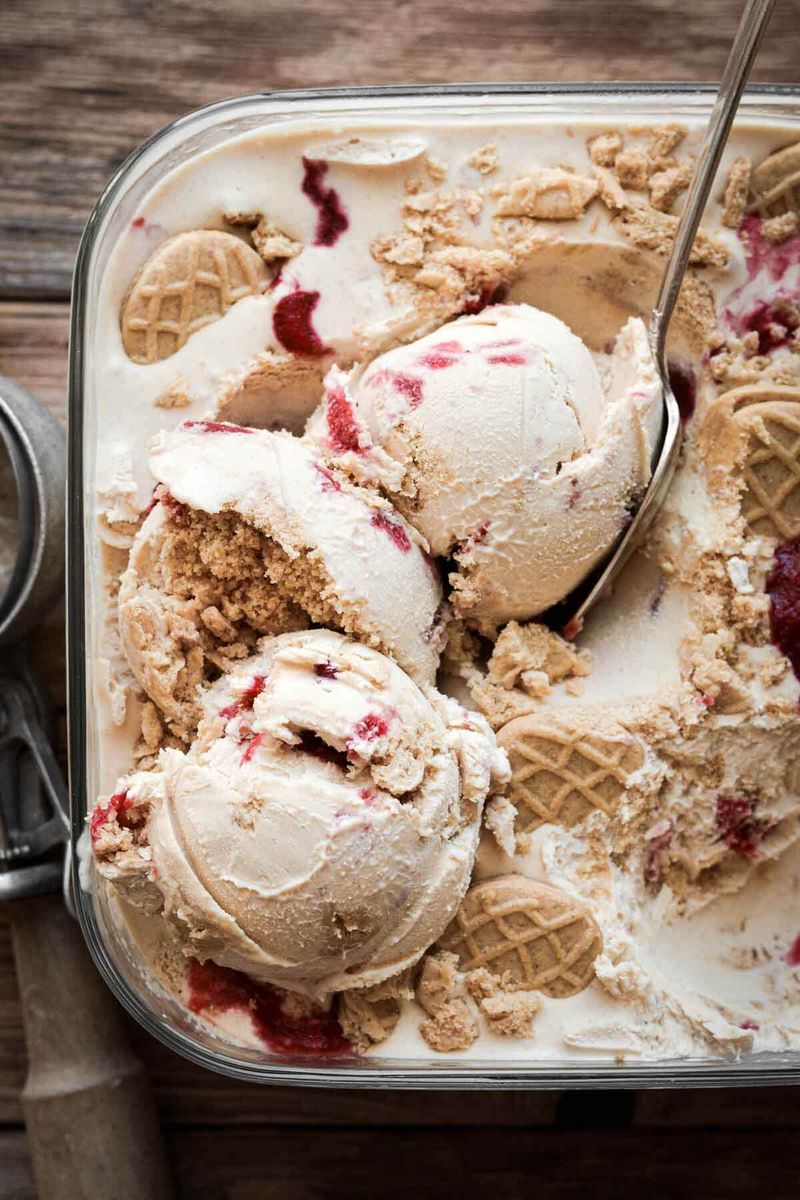
America’s obsession with PB&J extends beyond sandwiches into the frozen dessert realm. This ice cream features a vanilla or peanut butter base swirled with ribbons of grape or strawberry jelly and chunks of peanut butter cups or cookie pieces.
Boutique ice cream shops and major brands alike have created versions of this nostalgic flavor combination. The creamy-cold interpretation of a room-temperature sandwich confuses many international visitors who already find the original PB&J concept strange.
Ben & Jerry’s famous “Peanut Butter Jelly Time” flavor sparked collecting frenzies when released as a limited edition. Some creative American ice cream parlors serve it between two actual pieces of bread as an “ice cream sandwich sandwich” – a meta-dessert that perfectly captures American culinary playfulness.
19. Pumpkin Spice Everything
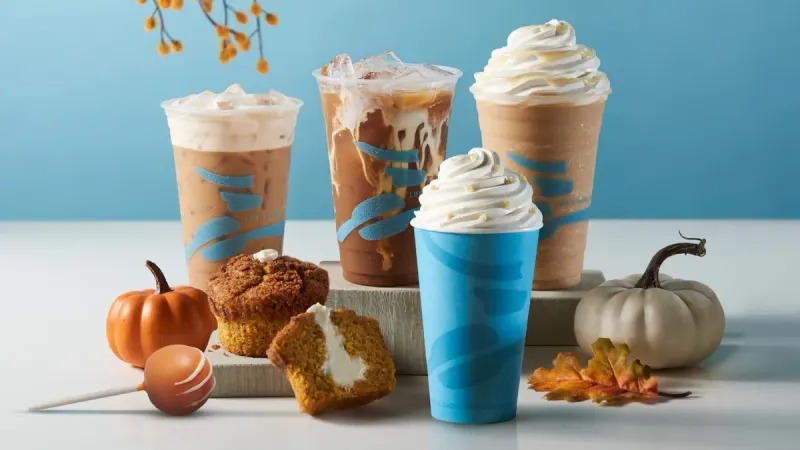
When autumn leaves begin to fall, America transforms into a pumpkin spice wonderland. This seasonal flavor phenomenon extends far beyond the infamous lattes to infiltrate yogurt, cereal, cookies, coffee creamer, and even savory items like hummus and pasta sauce.
The spice blend itself—cinnamon, nutmeg, ginger, cloves, and allspice—rarely contains actual pumpkin. Europeans find the ubiquity and artificially flavored versions particularly perplexing.
Major coffee chains begin promoting their pumpkin spice offerings earlier each year, now sometimes appearing in August. The flavor has become so culturally significant that it’s spawned memes, merchandise, and heated debates about seasonal creep. Market researchers estimate Americans spend over $500 million annually on pumpkin spice products during the fall months.
20. Casseroles with Canned Soup

The foundation of countless American weeknight dinners, casseroles built on condensed soup represent ingenious post-war convenience cooking. Cream of mushroom, chicken, or celery soup serves as a binding sauce for combinations of proteins, starches, and vegetables baked until bubbling.
Tuna noodle casserole—with its canned fish, pasta, peas, and crushed potato chip topping—particularly mystifies international visitors. Church cookbooks across America overflow with variations using canned soup as their base.
Food historians trace this cooking style to Campbell’s marketing campaigns in the 1950s. The one-dish meal concept resonated with busy American families. While gourmet cooks might scoff, these dishes represent authentic Americana, with regional variations like Minnesota hotdish or Southern hash brown casserole showcasing local preferences.
21. State Fair Foods on a Stick
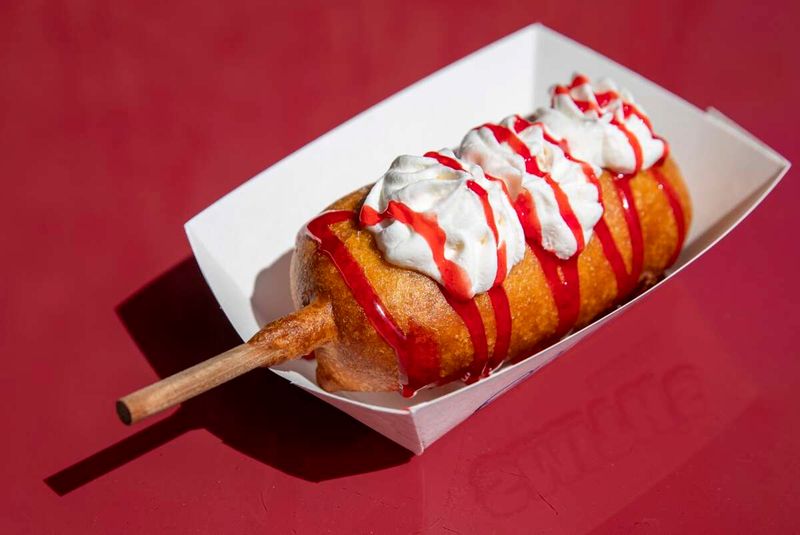
American state fairs have become competitive culinary laboratories where the only rule seems to be: “Can it be deep-fried and served on a stick?” From deep-fried butter to chocolate-covered bacon, these annual events showcase edible engineering that pushes boundaries of taste and physics.
The Minnesota State Fair alone offers over 80 different foods on sticks. Deep-fried spaghetti and meatballs, deep-fried cola, and deep-fried candy bars represent just the beginning of America’s fair food creativity.
Foreign visitors often watch in amazement as Americans eagerly line up for these once-a-year indulgences. The combination of novelty, spectacle, and shameless caloric excess makes state fair food a cultural phenomenon that perfectly captures America’s playful relationship with food and its love of reinvention.
Leave a comment